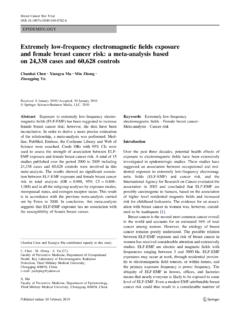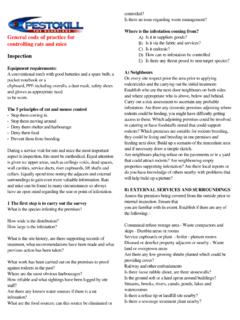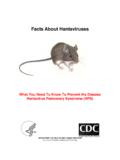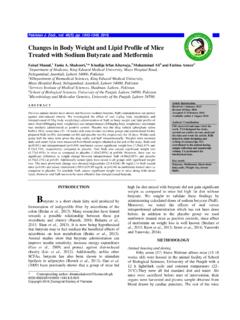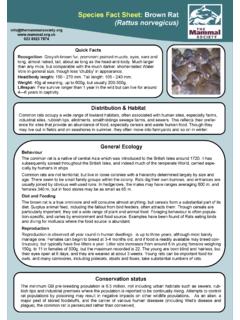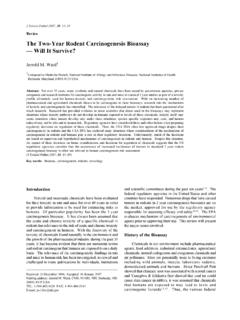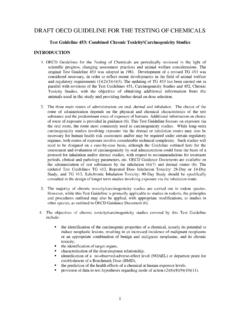Transcription of Deficits in Spatial Learning After Exposure of Mice …
1 Bioelectromagnetics 19:79 84 (1998). Deficits in Spatial Learning After Exposure of Mice to a 50 Hz Magnetic Field Zenon J. Sienkiewicz,* Richard Haylock, and Richard D. Saunders National Radiological Protection Board, Chilton, Didcot, Oxfordshire, United Kingdom A series of four experiments was performed to determine the effect of Exposure to a 50 Hz magnetic field on memory-related behaviour of adult, male C57BL/6J mice. Experimental subjects were exposed to a vertical, sinusoidal magnetic field at mT (rms), for 45 min immediately before daily testing sessions on a Spatial Learning task in an eight-arm radial maze.
2 Control subjects were only exposed to a background time-varying field of less than 50 nT and the ambient static field of about 40 mT. In each experiment, Exposure significantly reduced the rate of acquisition of the task but did not affect overall accuracy. This finding is consistent with the results of another study that found that prior Exposure to 60 Hz magnetic fields affected Spatial Learning in rats. Bioelectromagnetics 19:79 84, 1998. q 1998 Wiley-Liss, Inc. Key words: memory; radial arm maze; rodents; ELF. INTRODUCTION sostigmine was able to reverse the Learning deficits, suggesting that changes in central cholinergic transmis- Evidence is accumulating that Exposure to mag- sion were responsible for the observed effects.
3 Netic fields may affect Learning and memory in rodents, The present experiment was conducted to deter- although the conditions under which an effect can be mine whether Spatial Learning in mice would also be seen are not yet well defined. For example, the behav- reduced After Exposure to an intense magnetic field. iour of rats performing a Spatial memory task in a radial Here, the animals were exposed to a 50 Hz field at arm maze may be altered using specific combinations mT for 45 min each day immediately before a of static and time-varying fields [Creim et al., 1990; training session in an eight-arm radial maze.]
4 This ex- Lovely et al., 1991, 1992, 1993a, 1994], whereas the periment was not intended as an exact replication of performance of voles and deer mice in a water maze the previous experiment by Lai [1996] using rats, and may be altered using sinusoidal fields alone [Kavaliers there are a number of important differences between et al., 1993, 1996]. The magnitude of the observed the studies. These differences include operational dif- effects in both tasks tend to be rather small, and not ferences such as the frequency of the applied field all studies have reported significant effects; we found and the number of arms of the maze, and procedural that Exposure to a range of 50 Hz magnetic fields from differences such as the number of pretraining sessions 5 mT to 5 mT did not affect the Spatial memory of given to each animal and the number of arm entries mice in a radial maze [Sienkiewicz et al.
5 , 1996]. In that could be made each day in the maze. this study mice were exposed to a range of 50 Hz fields Biological effects of low intensity magnetic fields for a short time during testing in the maze; no changes are notoriously mercurial, and it has not always been in either initial performance, rate of Learning , or overall possible to replicate reported effects either at a later accuracy could be observed. date or by an independent laboratory. Examples include More recently, however, a much larger effect on field-dependent effects on pineal function and changes Learning has been reported. Male rats that had been in gene expression [Cridland et al.
6 , 1996]. Therefore exposed for 45 min to a 60 Hz field at mT before daily training sessions in a 12-arm radial maze showed a highly significant deficit in Learning , with exposed *Correspondence to: Dr. Sienkiewicz, National Radiological Protec- animals making consistently more errors in the maze tion Board, Chilton, Didcot, Oxon., OX11 0RQ, United Kingdom. [Lai, 1996]. Pretreatment with the choline agonist phy- Received for review 20 January 1997; revision received 27 May 1997. q 1998 Wiley-Liss, Inc. / 8510$$865d 01-07-98 09:12:35 bema W: BEM 865D. 80 Sienkiewicz et al. to check for the consistency and robustness of any 50 nT, and the static magnetic field was 40 mT.
7 The memory-related effect here, four separate experiments latter was horizontal ({57), aligned down the axis of were performed using different batches of animals. the magnet and orthogonal to the applied field. The axis of the magnet itself was aligned in a NNE direction. The radial arm maze is identical to that used be- MATERIALS AND METHODS fore [Sienkiewicz et al., 1992]. The maze was con- Subjects structed from Perspex and consisted of a central, octag- onal arena 24 cm in diameter, and eight arms each Male C57BL/6J mice at 12 14 weeks of age were 32-cm long. Close to the end of each arm was a small, purchased from the Medical Research Council Radio- circular food well.}
8 Access to and from the arms was biology Unit, Chilton. They were housed in individual controlled by the use of guillotine doors, these doors polypropylene cages (29 cm 1 15 cm 1 12 cm) in a being remotely operated by the experimenter using a colony room adjacent to the behavioural laboratory and series of solenoid-activated pneumatic cylinders. These were given free access to water and standard mainte- small solenoids were powered by 24 V DC and pro- nance diet (SDS RM-1) for 1 week before any proce- duced a maximum static field of 2 mT within the arena. dure. Bedding was provided by commercial sawdust The equipment within the laboratory provided visual (Litalabo; SPPS, Argenteuil, France).
9 The ambient con- cues to guide behaviour. Illumination was provided by ditions were maintained within the range 21 to 23 7C overhead fluorescent lighting. and 45 to 60% relative humidity. Lighting was pro- vided from 06:00 to 18:00 h. The background time- Behavioural Procedures varying fields were mT and the static field was All subjects were experimentally naive. They 44 mT. All procedures involving animals were carried were randomly assigned to either an experimental or out in accordance with the Animals (Scientific Proce- sham-exposed control group. Subjects were food de- dures) Act of 1986. prived to 85% of their free-feeding weight over the 14 days before testing, and they were maintained at Apparatus that level for the duration of the experiment.
10 Water The magnetic field Exposure system has been de- was always available in the home cages. scribed previously [Kowalczuk et al., 1993]. The mag- For preliminary training for both groups, each net consists of two sets of horizontal aluminium coils arm of the maze was baited with a food reward held 25 cm apart in a laminated steel yoke. The yoke (45-mg food pellet: BioServ, Frenchtown, NJ), and a and coils were vacuum impregnated with epoxy resin subject was placed in the maze for one session lasting to minimise vibration. The complete structure rests on 5 min. Once the subject was in the maze, all doors rubber mounts on top of a free standing iron frame.
